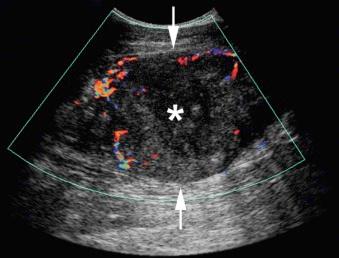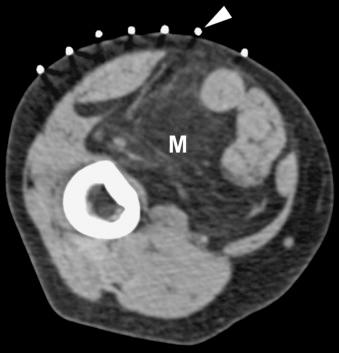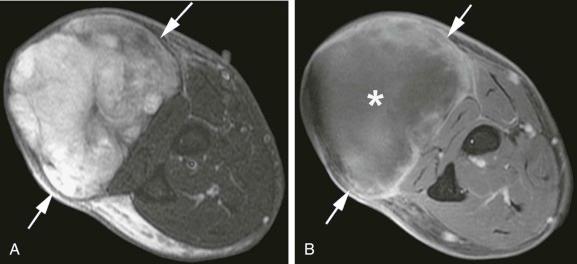Physical Address
304 North Cardinal St.
Dorchester Center, MA 02124
The incidence of soft tissue sarcomas in the general population is very low, 1.4 to 2.7 per 100,000, increasing for patients 80 years of age and older to 8 per 100,000. The majority (59%) of soft tissue sarcomas occur in the extremities, with the most common types reported to be undifferentiated pleomorphic sarcoma, liposarcoma, leiomyosarcoma, synovial sarcoma, and malignant peripheral nerve sheath tumor.
Although most soft tissue masses of the extremities are benign, excluding malignancy in a soft tissue mass by physical examination or imaging tests is often not possible because of the overlapping appearances of various types of benign and malignant tumors. Although there are a number of soft tissue masses that have characteristic CT and MR imaging features, many benign and malignant soft tissue tumors appear similar and can be diagnosed by biopsy only. Because orthopedic oncologic principles call for different avenues of therapy for benign primary neoplasms, metastases, and primary malignancies, achieving accurate presurgical diagnosis is a critical step for treatment planning.
If a biopsy reveals that the tumor is benign, it will likely be resected using the technique of marginal excision, in which the surgeon “shells out” the mass and leaves behind the pseudocapsule. When associated with benign lesions, pseudocapsules do not contain tumor cells but are instead made of compressed normal tissues.
If, however, biopsy results indicate that a mass is a primary soft tissue sarcoma, the higher likelihood of microscopic invasion of the pseudocapsule would necessitate a much more extensive operation—a wide local or radical excision of the mass, with a goal of achieving wide tumor-free margins. A diagnosis that indicates a metastatic etiology, however, will usually lead the clinician to perform a palliative treatment only, in addition to initiating a search for the primary malignancy.
Tumors can be sampled with an open technique, involving surgical exposure of the mass, or with a closed, minimally invasive, percutaneous needle procedure. Advantages of the open technique are the larger sample sizes and the ability to have the entire mass examined by frozen section. A rapid pathologic diagnosis would enable a quick decision about the need to convert to a radical excision, in case the lesion is found to be malignant. Disadvantages to open biopsies include high operating room costs and trauma to surrounding tissues, which would require a longer recovery time.
Several studies have shown that percutaneous needle biopsy of soft tissue sarcomas has good accuracy (75% to 88%) for diagnosis of exact tumor type and grade compared with final histology obtained at resection. These studies also showed that the percutaneous needle biopsies had a low complication rate of near 1%, which compared favorably with the rate of up to 17% reported for open biopsy procedures. Percutaneous needle biopsies have also been shown to use less anesthesia and cost 85% less than open biopsy procedures.
Percutaneous needle procedures can be performed by a surgeon without imaging guidance or by a radiologist using image guidance. The advantages of using image guidance for biopsy are numerous: the ability to visualize and avoid surrounding neurovascular structures, confirmation of needle placement within a solid and viable portion of the mass, and visualization of compartmental boundaries that should not be penetrated.
When planning a needle biopsy of an extremity mass, the radiologist should review the patient's medical chart for coagulopathies or usage of anticoagulant medications, such as warfarin (Coumadin, Jantoven). Because the effective half-life of warfarin ranges from 20 to 60 hours, the drug should be discontinued at least 2 days before the procedure and the prothrombin time and international normalized ratio checked to ensure recovery of coagulation function.
Before directing the patient to stop any medications, however, the patient's clinician should be consulted. The clinician may believe that there is a need to “bridge” patients with Lovenox (low-molecular-weight heparin) while Coumadin is stopped, to avoid life-threatening thromboembolic events in patients who are on the anticoagulant therapy for reasons such as atrial fibrillation, mitral valve replacement, or hypercoagulable states.
Clopidogrel (Plavix) inhibits platelet aggregation and is used to treat patients with cardiovascular atherosclerotic disease. Studies have shown that clopidogrel causes increased bleeding after transbronchial lung biopsy and femoral arterial punctures for cardiac catheterization. Because the duration of action of clopidogrel is 5 days, the drug should be discontinued for 5 days before any biopsy procedures. Aspirin and nonsteroidal anti-inflammatory drugs (NSAIDs) also inhibit platelet aggregation but prolong bleeding time to a lesser extent. It is unclear whether NSAIDs have a significant effect on bleeding after needle biopsies, but it is recommended that they be discontinued for 5 days before elective biopsies, when possible, and restarted 24 hours after the procedure.
In medically urgent cases, one may be asked to sample masses in patients who have not discontinued their antiplatelet aggregation medications, because extremity mass biopsy sites can easily be accessed for post-biopsy manual compression. These patients should be warned, however, that they would be at increased risk for post-biopsy bleeding and may need extended post-procedure compression at the biopsy site.
It is important that the radiologist recognize that, in cases of soft tissue sarcomas, a post-biopsy hemorrhage can be more than a minor complication. The likelihood of local recurrence of sarcomas after biopsy increases with the presence of post-biopsy hematoma, probably due to tumor cell dispersion and seeding of surrounding tissues.
Percutaneous biopsy of soft tissue masses can be performed with either CT, ultrasonographic (US), or magnetic resonance (MR) guidance. The choice of guidance modality depends on a combination of factors: the location of the target mass, ability of the modality to depict the mass, equipment availability, radiation exposure, cost, and the radiologist's familiarity with the modality.
Because US provides generally good soft tissue contrast resolution, along with real-time imaging capability and a lack of ionizing radiation, it is often an excellent means of biopsy guidance for soft tissue masses in the extremities. The masses best suited for US-guided biopsy are those situated at shallow to moderate depth from the skin surface, because the lesion-to-background signal-to-noise ratio declines rapidly with increasing depth. Visualization of all surrounding tissue planes, compartmental boundaries, and major neurovascular bundles, including those deep to the mass, is essential to avoid potentially deleterious contamination of surrounding structures with tumor cells.
Color Doppler US is useful for delineating vessels adjacent to and within the target mass. Avascular regions of the mass may be necrotic and should not be sampled because of the likelihood of a nondiagnostic yield ( eFig. 117-1 ), whereas markedly hypervascular regions of the mass may bleed excessively after biopsy and lead to localized tumor seeding.

For lesions that are difficult to clearly define with US, whether due to excessive depth or isoechogenicity with surrounding tissues, CT should be used for biopsy guidance. A preliminary CT scan series through the entire mass should be obtained to identify the most solid-appearing regions of the mass for the highest biopsy yield, to define the nearby compartmental boundaries, and to detect low-yield areas of cystic composition or necrosis. For assumed low-grade fatty lesions and those suspected of harboring a dedifferentiated component, the dominant nonlipomatous region should be targeted ( eFig. 117-2 ).

If the lesion-to-background contrast is not sufficient to fully delineate the mass on CT, intravenous iodinated contrast enhancement can be used to improve the lesion conspicuity, but the results will be short lasting. Correlation with any available MR images for anatomic landmarks can also be a useful technique for those lesions difficult to define on CT.
Although many soft tissue masses are first detected and best defined with MR studies, MRI is usually not necessary for biopsy of extremity mass lesions. Several MR-compatible biopsy needles are available, having been developed mainly for MR-guided biopsies of liver or breast masses, but costs for MR scanner time remain higher than those for US and CT. MR also lacks the real-time capabilities of US and the fast imaging speed of CT fluoroscopy. Metal susceptibility artifacts continue to compromise spatial resolution of metal needles on MR images.
Any available MR studies of the target lesion should be reviewed in the biopsy planning process, because these images often provide the best demonstration of the margins of the lesion as well as the surrounding neurovascular anatomy. Gadolinium-enhanced images should be reviewed to differentiate areas of enhancing, viable tissue from regions of nonenhancing tumor necrosis or cyst formation ( eFig. 117-3 ).

Become a Clinical Tree membership for Full access and enjoy Unlimited articles
If you are a member. Log in here